Jean Monty Doyle
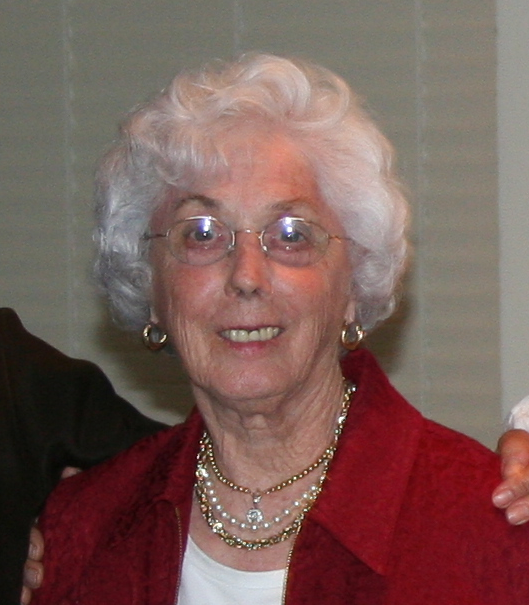
Jean Monty Doyle, age 96, passed away at her home on March 14, 2021. The youngest of six children, she was born in Omaha, Nebraska. The family moved to San Jose when she was three years old, and Jean considered herself a native Californian. Jean was an organizer, a planner, a manager, and a problem solver. She would graciously help you with as much or as little as you needed to solve your problem.
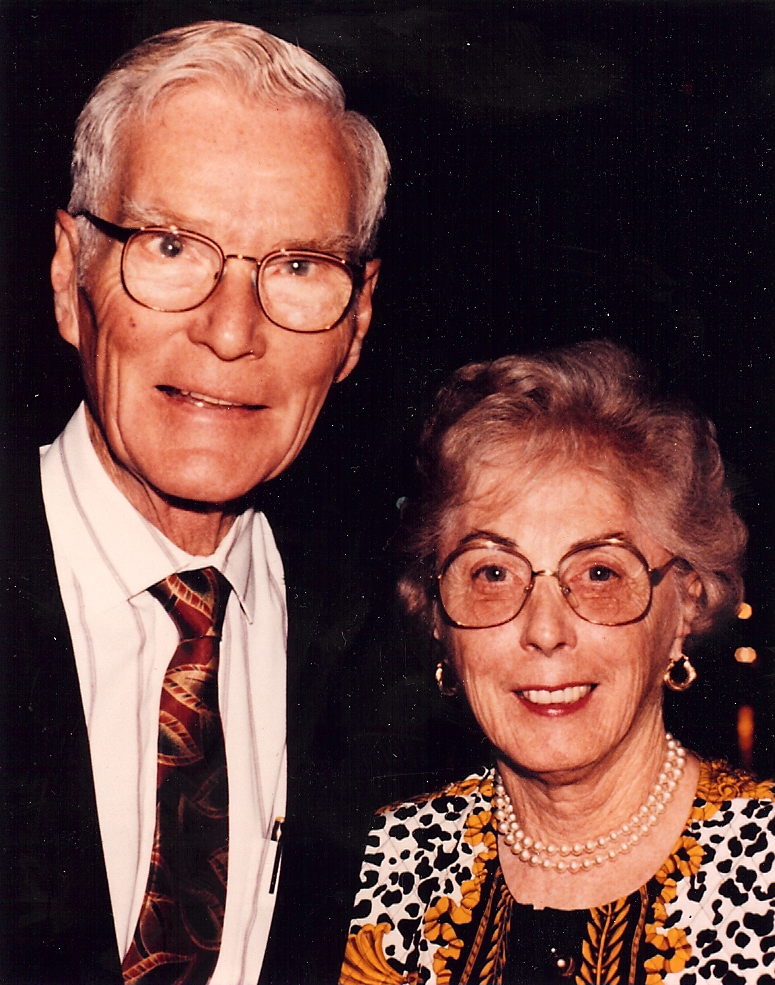
Jean wore many hats over the years. She was a registered medical record administrator and graduate of San Jose State University. Early in her career, she worked at San Jose Hospital Medical Center, in medical records, as well as the surgery and pathology departments. She also helped her brother, Dr. A.J. Monty, start the Santa Clara County Heart Association. At the request of the Santa Clara County Medical Society, she started the first medical personnel agency and medical secretarial service in San Jose. This led to her meeting her future husband David when she visited to enquire if he needed office help.
She later started a hospital transcription service and medical office consulting business, including establishing and managing a billing office for a group of physicians. New physicians contacted her and asked for help in starting their practices, including some of the first Vietnamese physicians in San Jose.
As part of her transcription service, she also wrote several handbooks which were published and used nationally. Her handbooks include “The Complete Handbook for Medical Secretaries and Assistants”, co-authored with Dr. Robert Lee Dennis, which got this rave review from Annals of Internal Medicine: “Retrieving this compendium from my secretarial-nurse staff evoked the response one might expect from Mama Bear when caught stealing one of her cubs.”
She was always extremely organized, and managed to have a successful career, run a busy household, and have an active social life. Her favorite pastimes were golf, ballroom dancing, and reading. She and her husband David traveled to many countries, and spent many happy hours dancing in each country that they visited, as well as at home.
Jean and David were very active volunteers with their daughter Christine’s Catholic schools. Jean organized student medical records for the schools to ensure everyone had gotten their childhood immunizations, in addition to providing help wherever needed. She and her husband became good and long-lasting friends with many of the high school band parents, who were ultimately dubbed “The Green Spaghetti Gang” after the fundraising spaghetti dinners. They chaperoned many of the high school band trips and had many a reunion dinner after all of their children had graduated.
In her retirement, she was a HICAP counselor for 16 years, helping seniors with their Medicare insurance questions and problems. She enjoyed sharing her medical insurance knowledge with seniors seeking advice.
She is predeceased by her loving husband David B. Doyle, MD, and her brothers, sisters, and parents. She is survived by her daughter Christine A. Doyle, MD, son-in-law Stephen Nelson, and several nieces and nephews.
Vaccines! Vaccines!
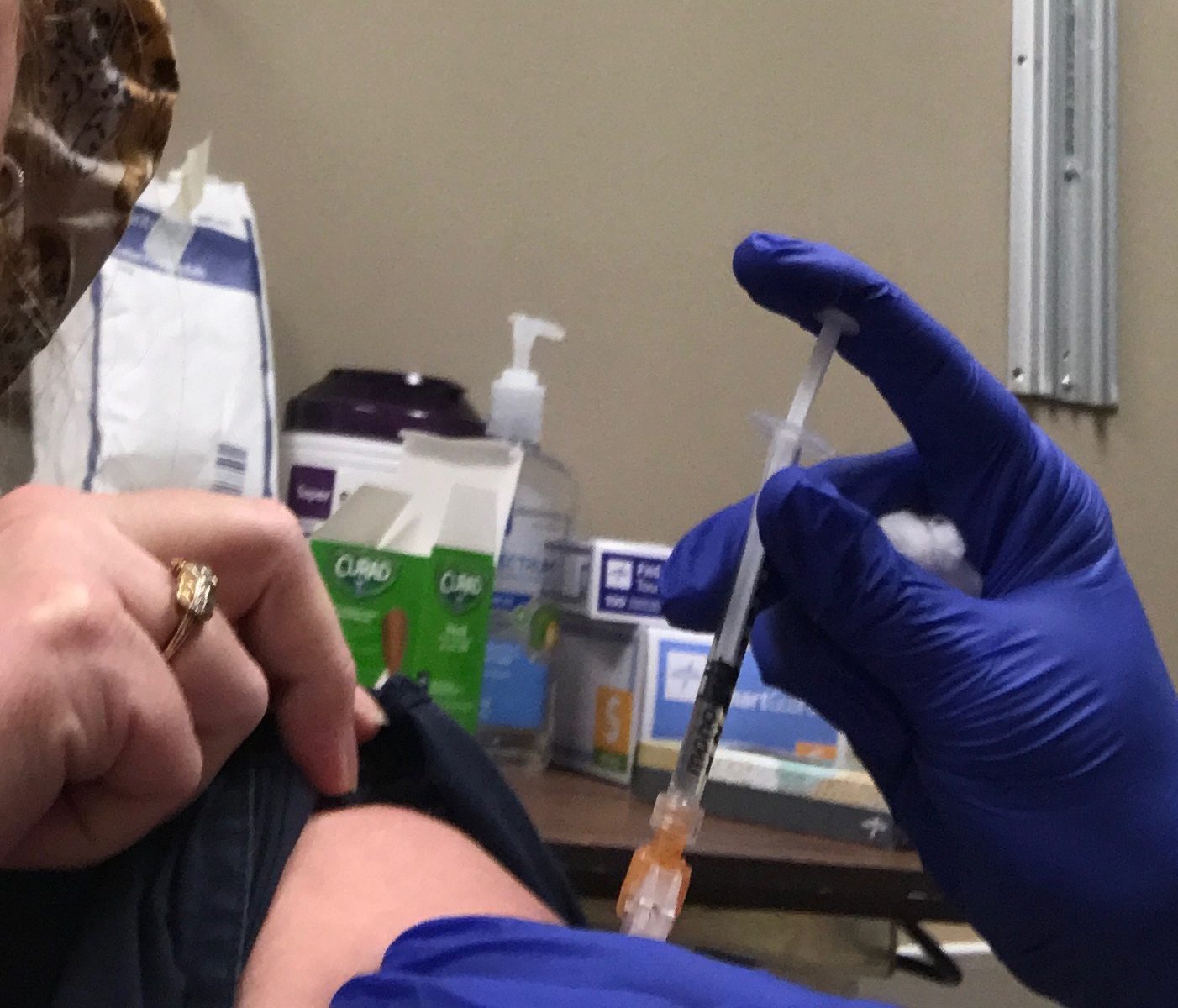
Just about everyone at the hospital was thrilled when we heard we would start giving vaccines to the staff before Christmas.
We started on December 17th, and had just over 350 people go through in 4 hours. We are now averaging well over 1000 doses per day within our hospital system and the county is now starting to branch out to other healthcare workers (physicians and their office staff), as well as our elderly and their caregivers. In just under 4 weeks, we have given well over 21,000 doses within our system and are giving second doses to those who were in the first week. This doesn’t include other facilities within Santa Clara County, like Stanford or Kaiser.
Do we know all of the fine details about the vaccines? Of course not. Just like this pandemic, what we know at the beginning is not what we will know 3 months or 6 months in the future, let alone years from now. We can’t say how long the vaccine will last yet (but at least 8 months). We don’t know whether folks will require booster vaccinations after the initial series.
Despite claims, this vaccine has gone through the exact same scrutiny that other vaccines have. We are doing the longer-term follow up, just like normal. What is different is the speed with which these vaccines were reviewed — on average, a new drug or vaccine sits in limbo for 2-3 years before the review is done. In addition, we had far more people in the studies than is typical. And we are continuing to do post-vaccination followups, not only with the study participants, but with everyone who is getting the vaccine. I expect in the end, both the Pfizer-BioNTech and Moderna vaccines will be the most studied vaccines we’ve ever had.
Yes, mRNA vaccines are new. But we have been studying them for a couple of decades, and they are being looked at as possible anti-cancer vaccines. Sounds like a SciFi novel, but reality gets closer to fiction every day. They don’t change your DNA, because they can’t. They do use your body’s “assembly line” to make the protein that stimulates the antibody creation. That’s the same thing that a virus does.
Most of the reactions that people are talking about are the same reactions your body has when fighting off any infection, whether bacterial or viral. Fever, chills, body aches. It means things are working. Not everyone has the same reaction, and not everyone will have the same reaction with both doses.
Please get your vaccine as soon as your are able to do so.
Boosting Bluetooth Range
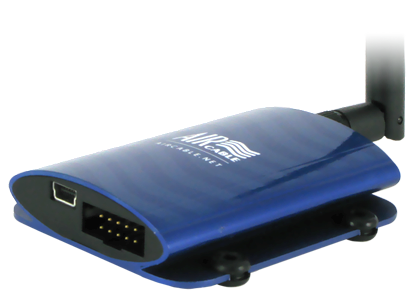
I got a Bose SoundSport headset earlier this year, and it’s quite nice when I’m trying to do work around the office… except for when I walk out of range. Unfortunately, the range issue was happening even within my 13’x13′ office.
So I asked for a bluetooth booster for the holidays, and I received an AIRcable Host XR5. Small device, with an adjustable antenna and a mini-USB cable. The experience has been a bit mixed.
The device arrived with no instructions. The website has no instructions. We could only find a few comments on the web: turn off the Bluetooth on the computer before plugging the device in, wait 5 minutes or so, download Xcode, etc. Not that helpful.
Although there is no specific Documentation or Technical Help page on their website, I was able to find this: https://aircable.co/blog/aircable-news-1/post/the-aircable-host-xr-on-a-mac-37 Even this blog post is a bit short on details, as key steps are buried in text instead of in the bullet list.
To make this work you need to:
- Make sure that you are using a wired keyboard and mouse.
- Ensure that Bluetooth shows on your menu bar at the top of your screen.
- Hold “shift” and “option” together and then click on the Bluetooth icon. This will bring up a variation of what you normally see, which includes the MAC address. Note down that MAC address, since you will need to see a change to verify that the device is working. The AIRcable MAC address will start with 00-25-BF-
- Turn off your Bluetooth.
- Choose DEBUG and remove all of your devices.
- Plug in the device to a *powered* USB port. The light will appear red.
- Turn Bluetooth back on. Wait about 5-10 seconds, and the icon will return and the light will change to a reddish-purple (not blue) and flickering/flashing.
- Pair your devices if they don’t come up automatically. Airpods and other Apple devices will not automatically appear, and will require manual re-pair.
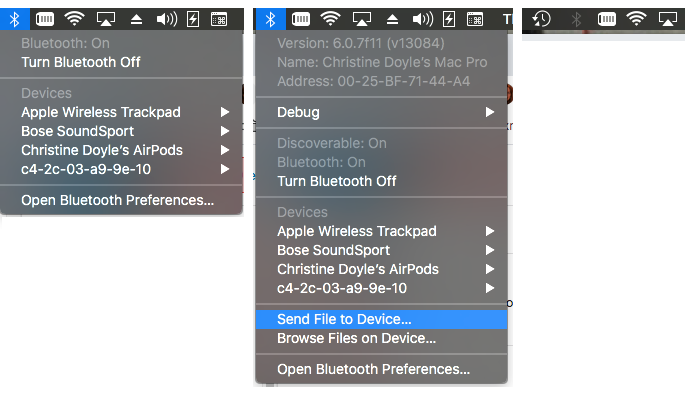
Once you get this setup, it may be unstable initially, and keep dropping. Be patient. Make sure that the antenna is upright (not flat on the table/surface). And it may drop periodically, even when sitting still at your desk. It’s unclear what makes that happen, but it will reconnect automatically.
The other issue with Bluetooth headphones is which codec is used as the default. You can check that by using “option” when clicking the Bluetooth icon. If you are sending audio to your headset, you should be able to click on it and see which codec is being used. If you’re using AAC or aptX, you will get better audio than using the SBC codec. For more details on how to optimize this, look here: https://www.macrumors.com/how-to/enable-aptx-aac-bluetooth-audio-codecs-macos/
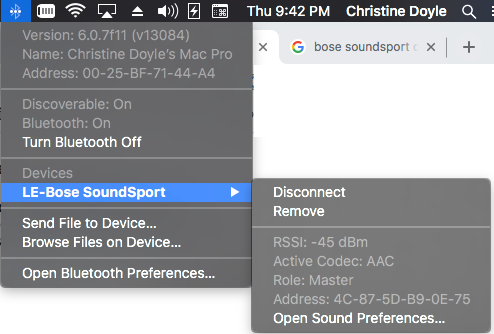
Mind the Gap

Bridging the Gap between Wanting to be a Leader and Getting There.
A Practical Guide for Women in Anesthesia.
If you attended the ASA Virtual Meeting presentation on October 3rd, or are watching the recording, here are the recommended readings about Sponsorship, with links to the articles. Each will open in a new window.
- Forbes: How to Turn a Mentor Into a Sponsor
- HBR: A Lack of Sponsorship Is Keeping Women from Advancing into Leadership
- HBR: Sponsors Need to Stop Acting Like Mentors
- HBR: What Men Can Do to Be Better Mentors and Sponsors to Women
- HBR: Women are Over-Mentored (but Under-Sponsored) *podcast episode
- NYT: Mentors Are Good. Sponsors Are Better.
- The Muse: 3 Smart Ways to Upgrade Your Elevator Pitch
- The Muse: The People Who Can Open More Career Doors Than You Ever Thought Possible
Of note, the most useful references on this topic, as well as the others in our SnapTalk presentations, do not come from typical medical references, but from the various business and tech sites that talk about professional development.
I may have periodic updates, but will note which items are new.
Masks, Masks, and More Masks
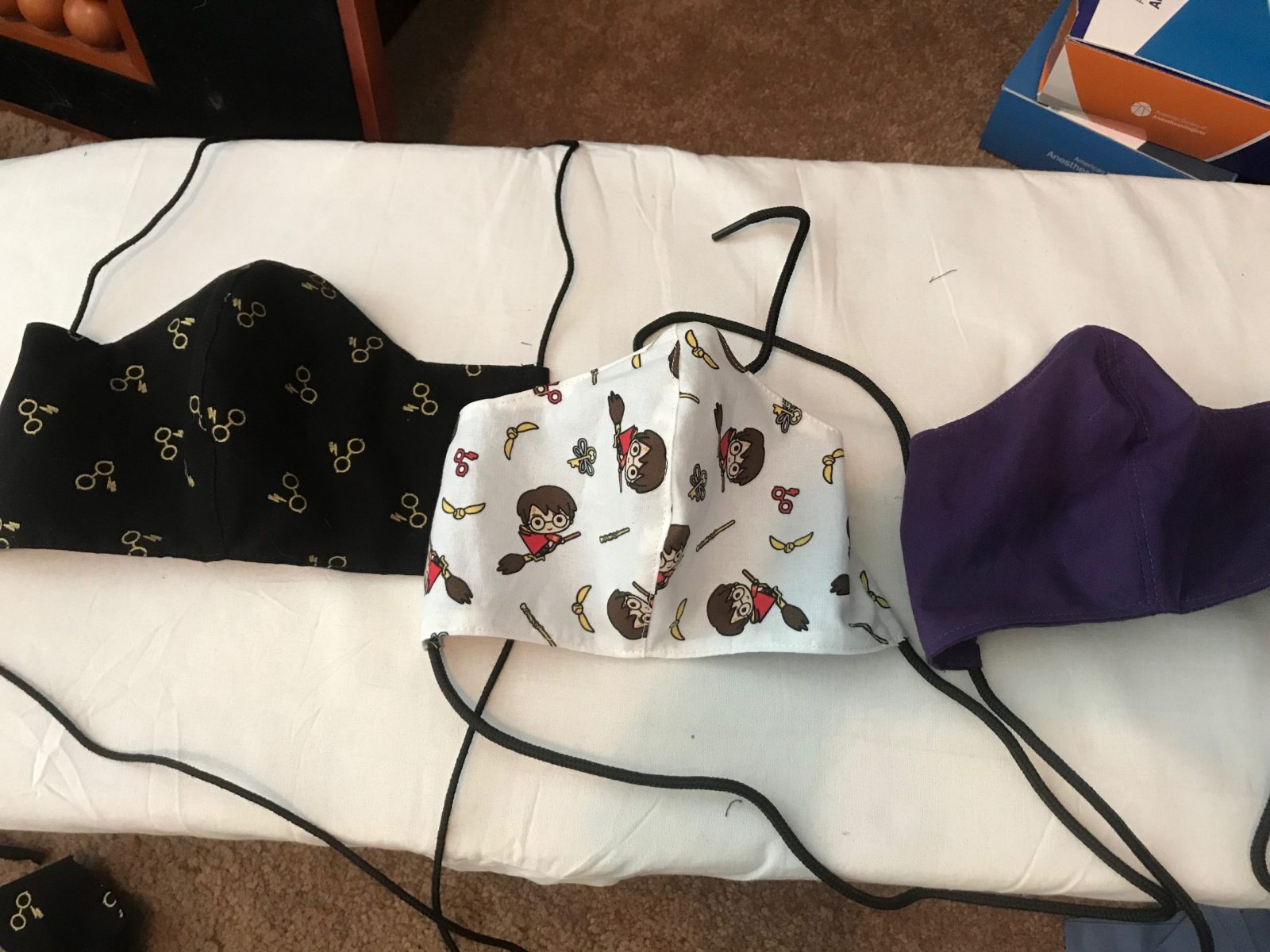
With the pandemic continuing worldwide, most communities require masks if you’re outside of your home. What are the different types of masks, and which one should you be wearing?
What is the purpose of a mask (or gloves, or cover gowns)? It depends a bit on context. Masks can be used to protect you, or can be used to protect others, or both.
Personal Protective Equipment (PPE) can be rated depending on the context. Are you looking for protection from fire/burns/electrical? Or protection from biohazards? It totally changes what recommendations are made.
PPE for biohazards typically includes respiratory protection (a variety of masks and respirators), eye protection (goggles and face shields), and skin/hand protection (gloves and gowns).
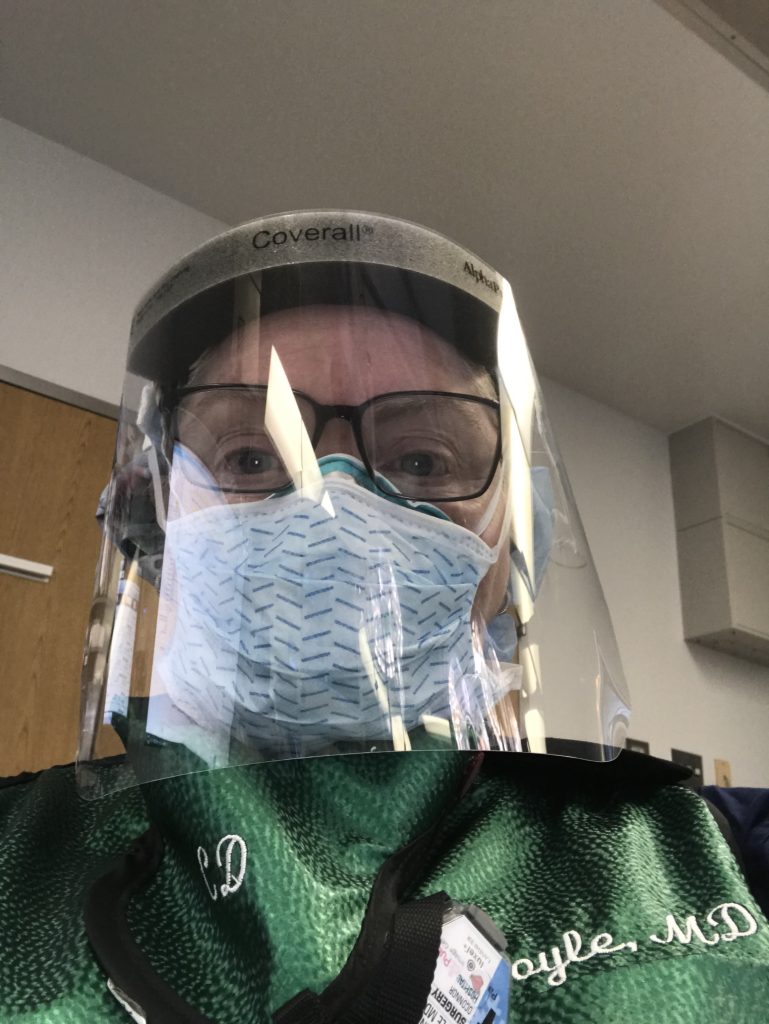
plus a lead apron for x-ray protection.
Masks also have different levels of protection, based on how fine they are and what can get in (or out). Any mask made of fabric or a paper-type product will freely allow oxygen and carbon dioxide to pass; hard plastic masks like scuba or others require a source of fresh air.
The shape of the mask and the way it’s secured also has a role to play in how effective the mask is. Masks can be pleated, cone-shaped, duck-bill, or contoured. They can have an ear loop, an elastic strap, or ties. Each has issues related to fit and efficacy.
I strongly suggest you view this video from Sewstine (also an anesthesiologist), as she makes 4 different types of masks and formally fit tests them. And provides the research behind it all.
Mask Ratings:
Masks are rated by either NIOSH (in the US) or the European Safety Federation (ESF). They will be rated for Particle Filtration Efficiency (PFE) and may also be rated for Bacterial Filtration Efficiency (BFE). They are considered Air-Purifying Respirators because they protect by filtering particles out of the air you breathe.
Both ratings organizations classify masks based on the percentage of airborne particles that are filtered. For NIOSH, the number of the mask is approximately the percentage of the PFE. NIOSH approved masks also have a letter, which has to do with how the mask deals with oil.
- N – solid and liquid aerosols that do not contain oil (Non-oil)
- R – solid and liquid aerosols that may contain oil (Resistant to oil)
- P – solid and liquid aerosols that may contain oil (Protective to oil)
The European P2 mask or FFP2 filter is equivalent to the NIOSH N95. The P3 or FFP3 is equivalent to the NIOSH P99.
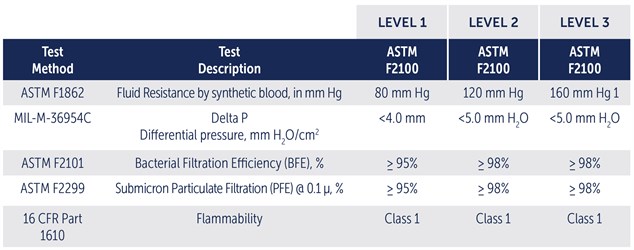
Dust Masks aka “nuisance” masks, that you might get at the hardware store, are good for things like gardening, and some tasks like painting or light sanding, but are not adequate for pandemic protection, particularly not in close or indoor situations.
Gaiters will depend on the fabric that was used to make them. Fleece as a whole provides warmth but no filtration efficacy. Many performance fabrics are designed to “breathe” and may protect you, but not protect others.
What about Powered devices?
Powered Air-Purifying Respirators (PAPRs) are types of hoods which have a battery-operated blower that sends purified (filtered) air from a device on a belt or backpack up to the hood so you are breathing clean air. Controlled Air-Purifying Respirators (CAPRs) are a proprietary variant, where the filtration all happens in the helmet portion of the hood. Ortho-hoods, used to protect surgeons during orthopedic surgery, are not filtering the air, so are inadequate alone (but may be used in conjunction with an N-95 mask).
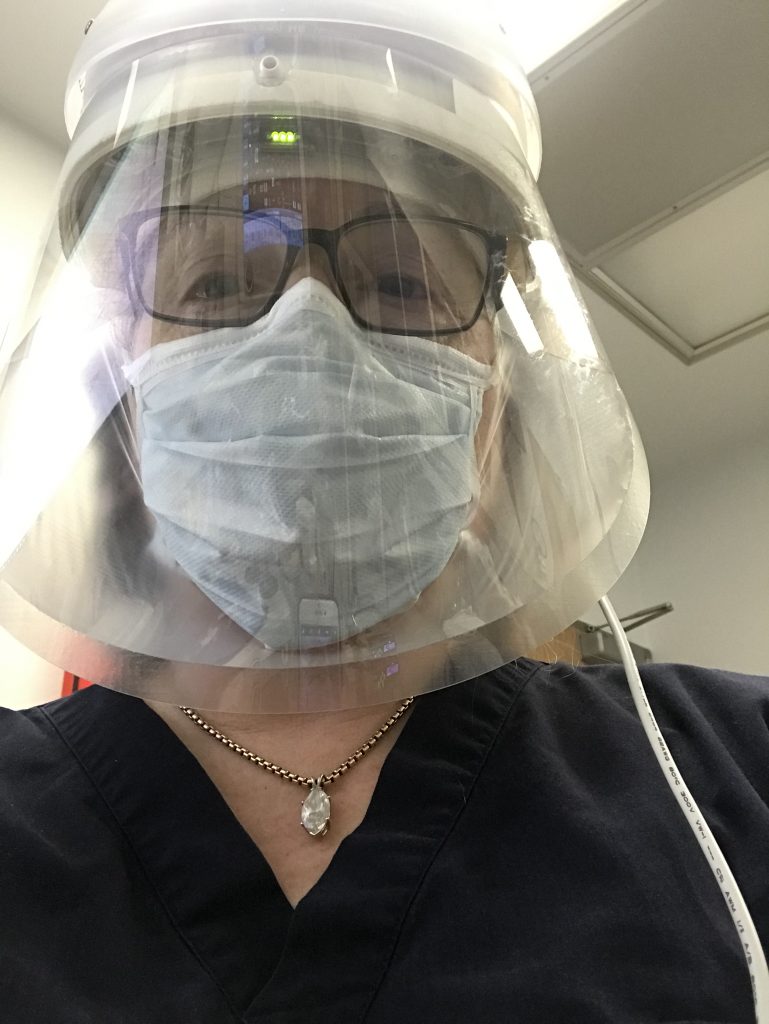
Closing Thoughts
If your goal is a secure fit to prevent aerosol transmission, the mask or other device will need to be very tight to the face. And it will probably be uncomfortable in some way because of that fit. But it will *not* adversely affect your ability to breathe in oxygen or exhale carbon dioxide.
Other resources & reading:
- https://www.sciencealert.com/simple-low-cost-experiment-reveals-which-face-masks-are-best-at-blocking-droplets The way they did the testing is actually more useful than the actual masks they were using.
- I sewed and fit tested four different masks…
Making Drapes
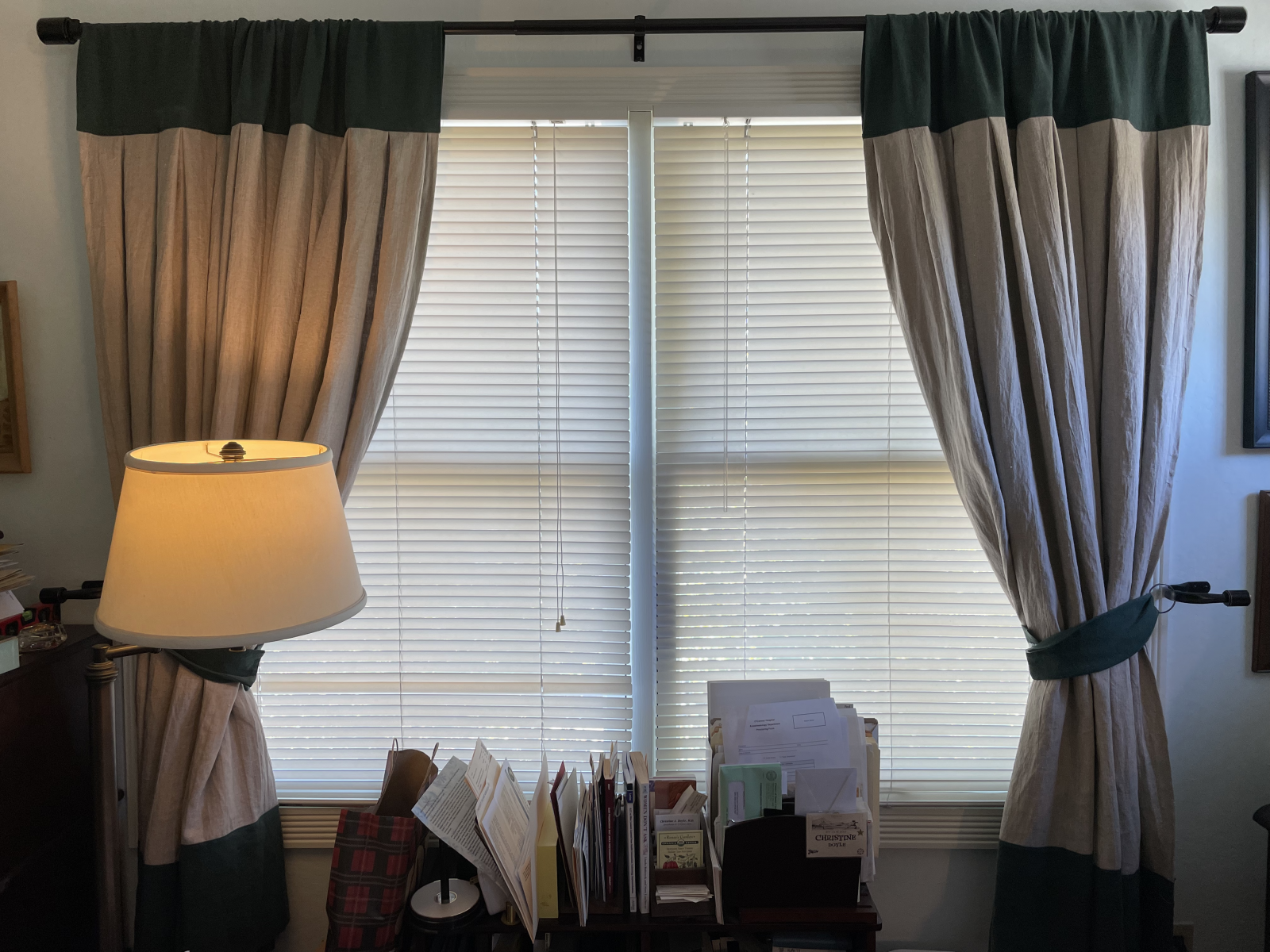
It’s been years since I last made drapes, but the back-light in my office has become a problem as we do more video conferences. So, I need drapes that will help balance the lighting in the afternoon.
I ordered some inexpensive backdrop drapes from Amazon. When they arrived, they were still too light-weight, and I would need more of them to get enough fullness to get any sort of light-blocking effect. Most of the drapes you can get at any retail store are really designed to just be hanging on the edge of the window — they are in no way designed to be drawn across the window, even when they are advertised as black-out drapes. The panels aren’t full enough, and if you need 2 (or more) sets, then you have the gap between panels.
Time to design drapes. In this case, I wanted something full enough that it would give good coverage when drawn, but be able to be tied back most of the time, so I could easily adjust the blinds.
The last time I made drapes, I did balloon shades for my room at parents house, over 25 years ago. Balloon shades can be raised to various degrees or left down. They should be long enough to puff at the bottom when fully down. In this case, I also put a swag and jabots at the top. Because it was a bow window, I ended up doing 5 separate drapes, one for each window, and put the pulls into two batches. These replaced the classic pinch pleat drapes and sheers, which had finally fallen apart from the heavy sun exposure. My mother was concerned that they would “look like a sheet” from the outside, but you can put in enough gather that it looks just fine.
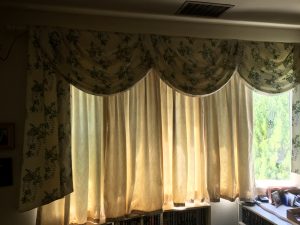
Given the size of the window and the length I wanted, and a deadline for an event, I took a look at what I had in my stash. Natural linen was an easy choice, but would need a lining to get me adequate light blocking. I could use the cheap drapes as the lining. But I would need a bit more length. Color block patterns seemed like a good way to go, and I picked a green that would work well with the walls.
A brief digression into terminology.
– Stack: how wide the fabric is when the drapes are fully open
– Fullness: the width of the fabric in relation to the curtain rod. Usually should be 2-3x.
– Railroading: using the fabric “sideways” or cross-grain. This minimizes the number of seams
See also this nice post: https://www.dwfcontract.com/Drapery–Window-Covering-Blog/bid/34627/Glossary-of-Drapery-Terminology
Fabric ordered, should have been easy. FedEx sent the package from LA to Texas, instead of to Northern California. And then lost it. Deadline blown. They found it a week later, and got it to me nearly 2 weeks after the date I was aiming for having these done. Oh well.
Wash fabric. Iron fabric. Re-iron fabric using steamer. Cut panels of the natural linen. I thought about using it cross-grain, but the natural creases would then have been horizontal, and I didn’t think that would look all that great. On the other hand, the green didn’t drape quite the same way, and was perfect for railroading the contrast bands. Find enough floor space to lay everything out (the hardest part).
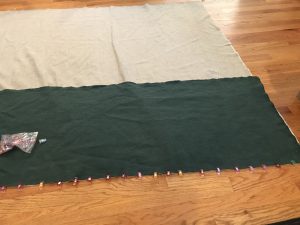
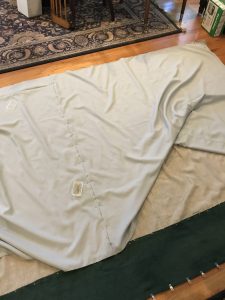
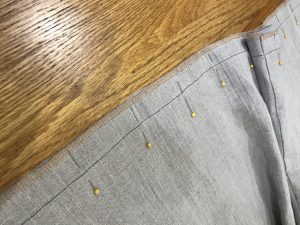
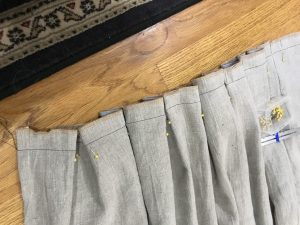
I opted to use a series of inverted pleats. This is what you will see in theater scrims (the drapes on the sides and back of the stage). It provides a lot of volume but isn’t that fussy to do — certainly not like pinch pleats. But I didn’t want a lot of volume at the top on the rod, so added the header block after the pleats were finished. And then finally added the tie-backs to hold them back when I don’t want them down.
Coronavirus, COVID-19 and resources

We’re all overwhelmed with the information out there. This is an attempt to bring some of the best pieces together into one location. I have divided things into Peer-Reviewed articles (i.e., the medical journals), News articles, Websites/Blog posts, and some of the California county health department sites and recommendations. Not all of these are new, but bringing it all together is.
Peer-Reviewed articles
News articles
Websites/Blog posts
California Counties
The Biggies:
CDC: https://www.cdc.gov/coronavirus/2019-ncov/index.html
WHO: https://www.who.int/emergencies/diseases/novel-coronavirus-2019
ASA: https://www.asahq.org/in-the-spotlight/coronavirus-covid-19-information
ASPF: https://www.apsf.org/news-updates/perioperative-considerations-for-the-2019-novel-coronavirus-covid-19/
CDPH: https://www.cdph.ca.gov/Programs/CID/DCDC/Pages/Immunization/ncov2019.aspx
SCCM: https://www.sccm.org/disaster?utm_source=3%2F12%20-%20NEWS&utm_medium=Link&utm_campaign=eNewsletter&_zs=0hMjd1&_zl=b6db6
Peer-Reviewed articles:
- NEJM Coronavirus Summary
a collection of articles and other resources - Practical recommendations for critical care and anesthesiology teams caring for novel coronavirus (2019-nCoV) patients
good review of the PPE requirements - The Internet Book of Critical Care
great review including the primary clinical characteristics of both strains - Care for Critically Ill Patients with COVID-19
resources if you need to care for these patients in a critical care setting - Critical Care Utilization for the COVID-19 Outbreak in Lombardy, Italy
Early experience and some forecasting of needs - Clinical Characteristics of Coronavirus Disease 2019 in China
published 2/28/2020, with an associated editorial from the head of NIAID, NIH, and CDC — by which time we were already seeing it far beyond China - First Case of 2019 Novel Coronavirus in the United States
e-pub before print on 3/5/2020 — when we had >1000 cases in the US - Contamination: a comparison of 2 personal protective systems
where folks are likely to get contaminated if they aren’t careful with their PPE - Public health interventions and epidemic intensity during the 1918 influenza pandemic
fascinating study of how different public health responses changed the infection and death rates - An interactive web-based dashboard to track COVID-19 in real time
this is the group who put together the dashboard by the Johns Hopkins team
News Articles:
- I Lived Through SARS and Reported on Ebola. These are the Questions We Should be Asking About Coronavirus
A reporter talks about the way we ask questions… how many people can we test (not how many tests can we run), etc. - How Bad Is the Coronavirus? And What You Can Do to Curb Its Spread
The author consolidates information from many different sources into a great overview. - The Extraordinary Decisions Facing Italian Doctors
Triage on a scale most of us have never considered. - The Korean Clusters
How one person can expose over 1000 to the virus - These Common Household Products Can Destroy the Novel Coronavirus
What works and why, and why you don’t need to stockpile toilet paper - How Epidemics like Covid-19 End (and how to end them faster)
Great article about how diseases spread and epidemics stop. Some of the same stuff I’ve talked about in my Understanding Risk & Uncertainty presentation, but with interactive graphics!
Websites & Blogs
- The Coronavirus Dashboard
Created by a 17 year old student - Epigenetic testing to track mutations and spread of virus
Fascinating “genealogy” of the fast-spreading virus - Cryptic Transmission of Novel Coronavirus
Easy to understand explanation of mutations and how to track spread - Hopkins Dashboard
From the ID team and engineering group at Johns Hopkins - Flatten The Curve
This MPH has a background in vaccines and infections diseases.
California County Info
I’m focusing on the Bay Area, since that’s where I live and work.
Holiday Lights – LEDs Part 1
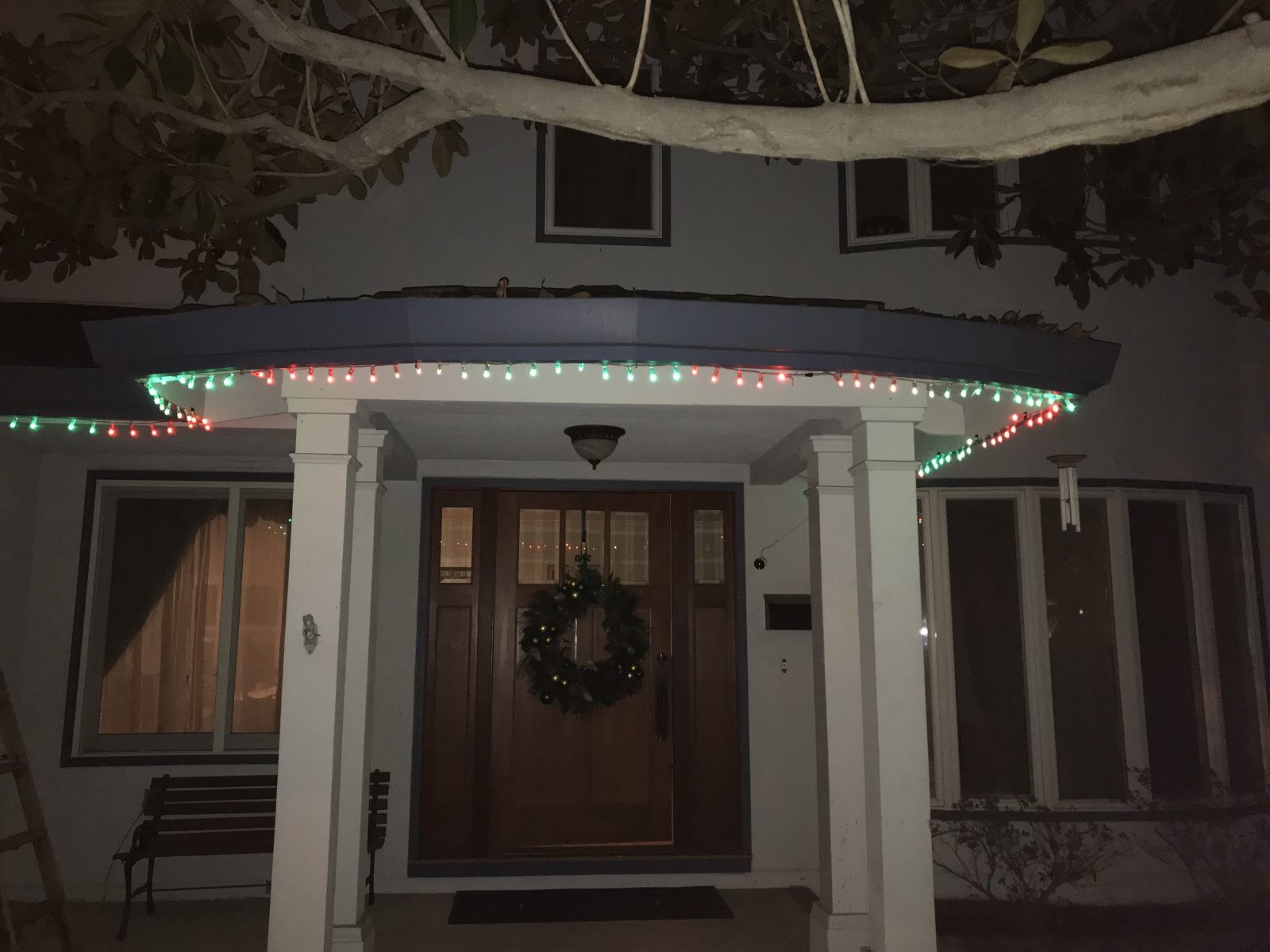
After we remodeled the house, we put up the old holiday lights that had been used at my parents. You can see them in the photo on the remodel pages.
But we were interested in having other options, like orange/purple for halloween, or pastels for spring. Programmable LEDs seemed to be the way to go.
After some research, we settled on the Alitove lights, which are available via lots of on-line retailers. We got the first set last year, and never did anything with them. Finally this year, we put them up and were able to program them with the free app they include, doing a red/green chase. Two strands were enough to do the front porch (about 20-21 linear feet).

the bundle of lights 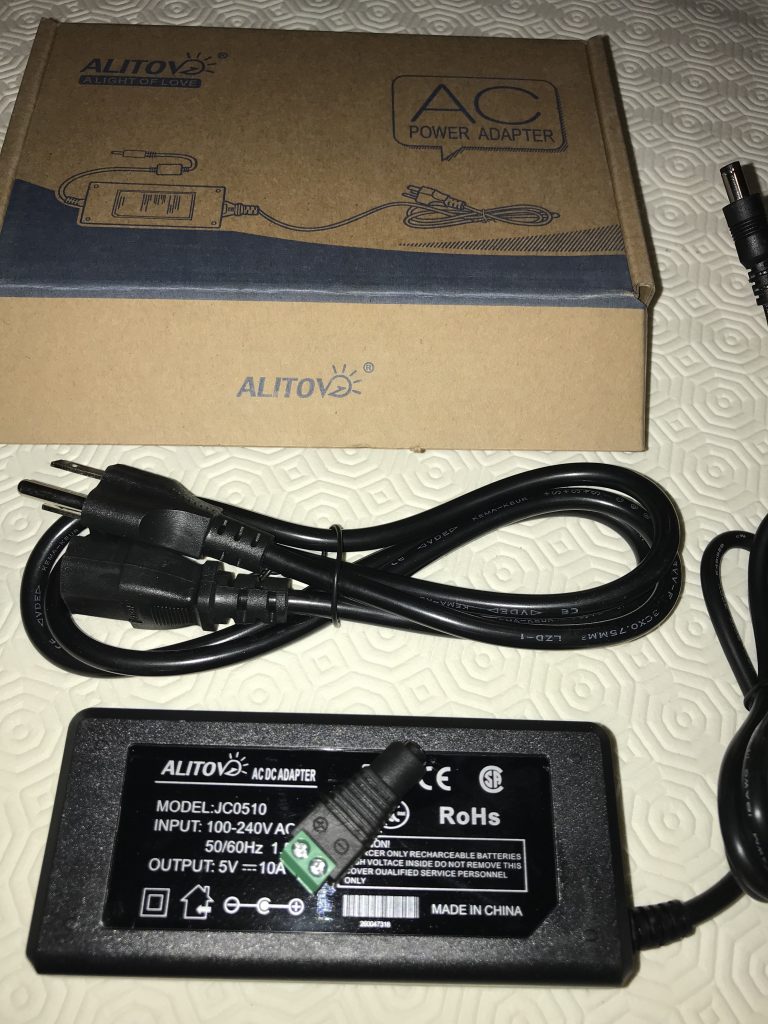
the standard power supply 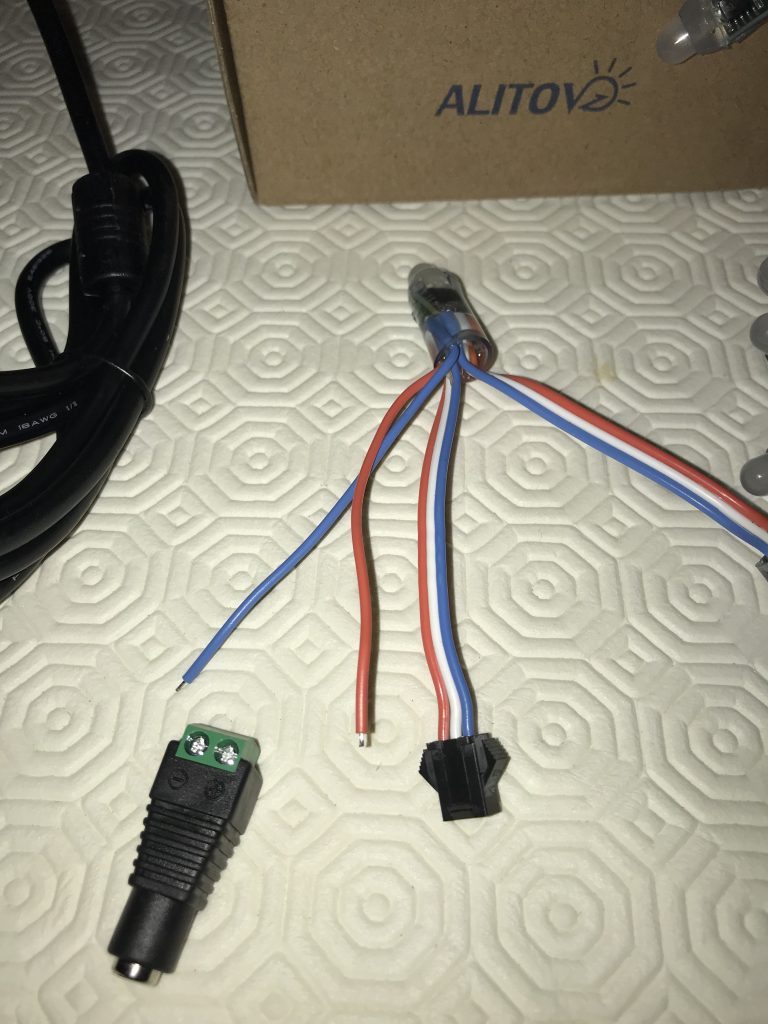
the end of the strand has two free wires
to attach to the power supply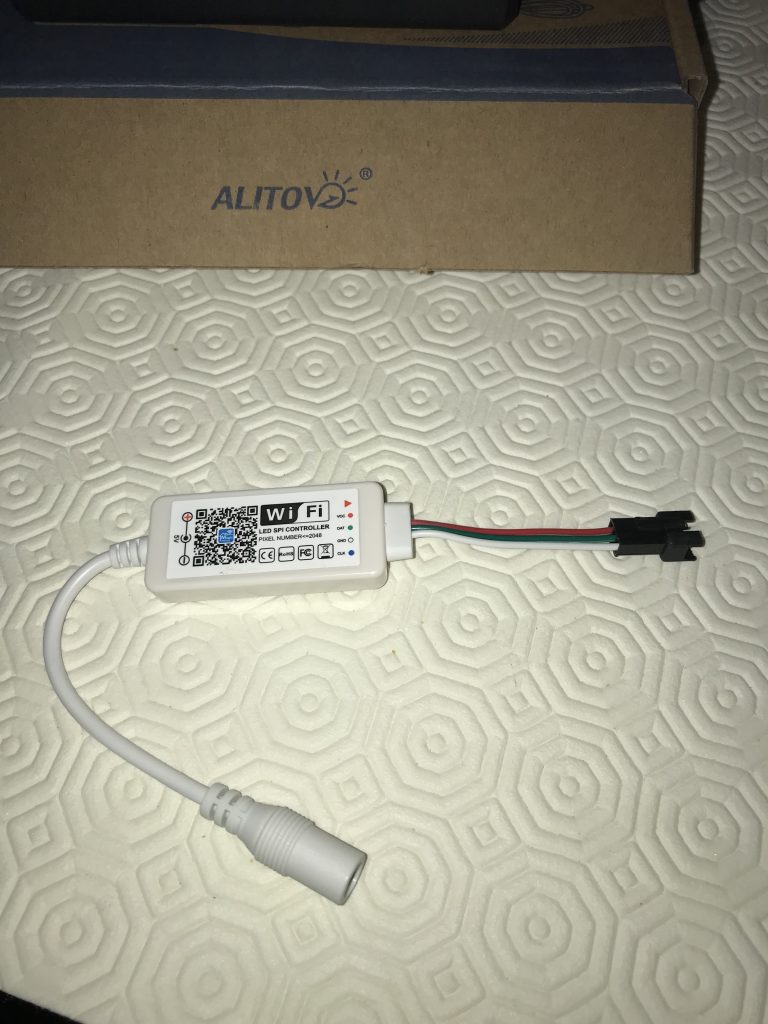
the adaptor to connect to the app 
basic white during testing
We used zip/cable tie adhesive mounts with small/short cable ties to mount the lights on the inside of the eaves, so that the lights showed just below the edge.
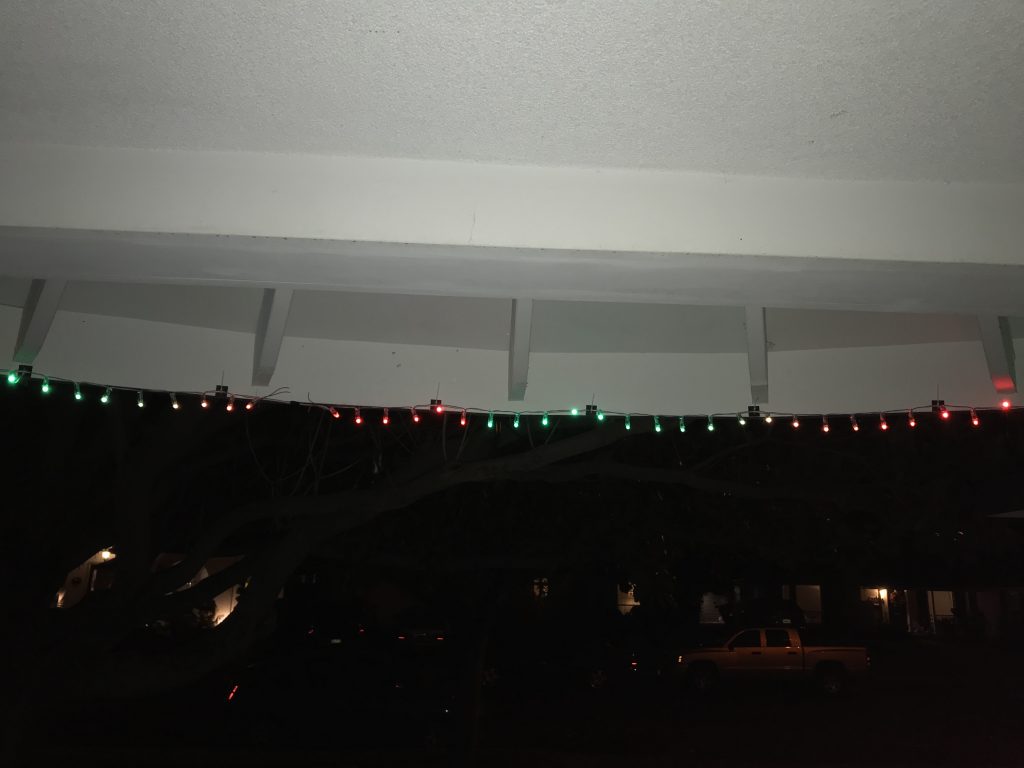
lights from inside the porch 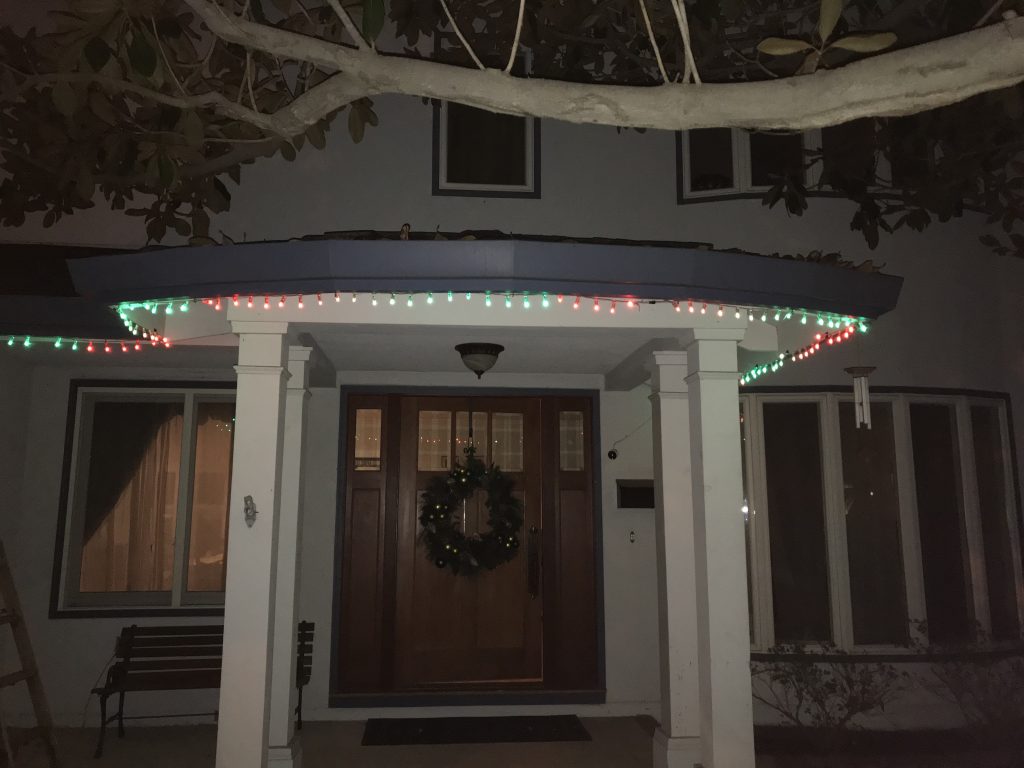
lights as seen from the walkway
The real question was how many lights could be put onto a single power source before we saw fade. The Alitove website doesn’t really say (although they show some impressive displays); the Amazon website description says 3 or 4 strands. Each strand has extra wires for additional power — but what happens if you add power to the middle of a long strand? or do you need to have multiple controllers? (and how do you keep them in sync?) The controller we bought this year does not use the same app as the one we bought in 2018. Now what?
3-Roomba Household
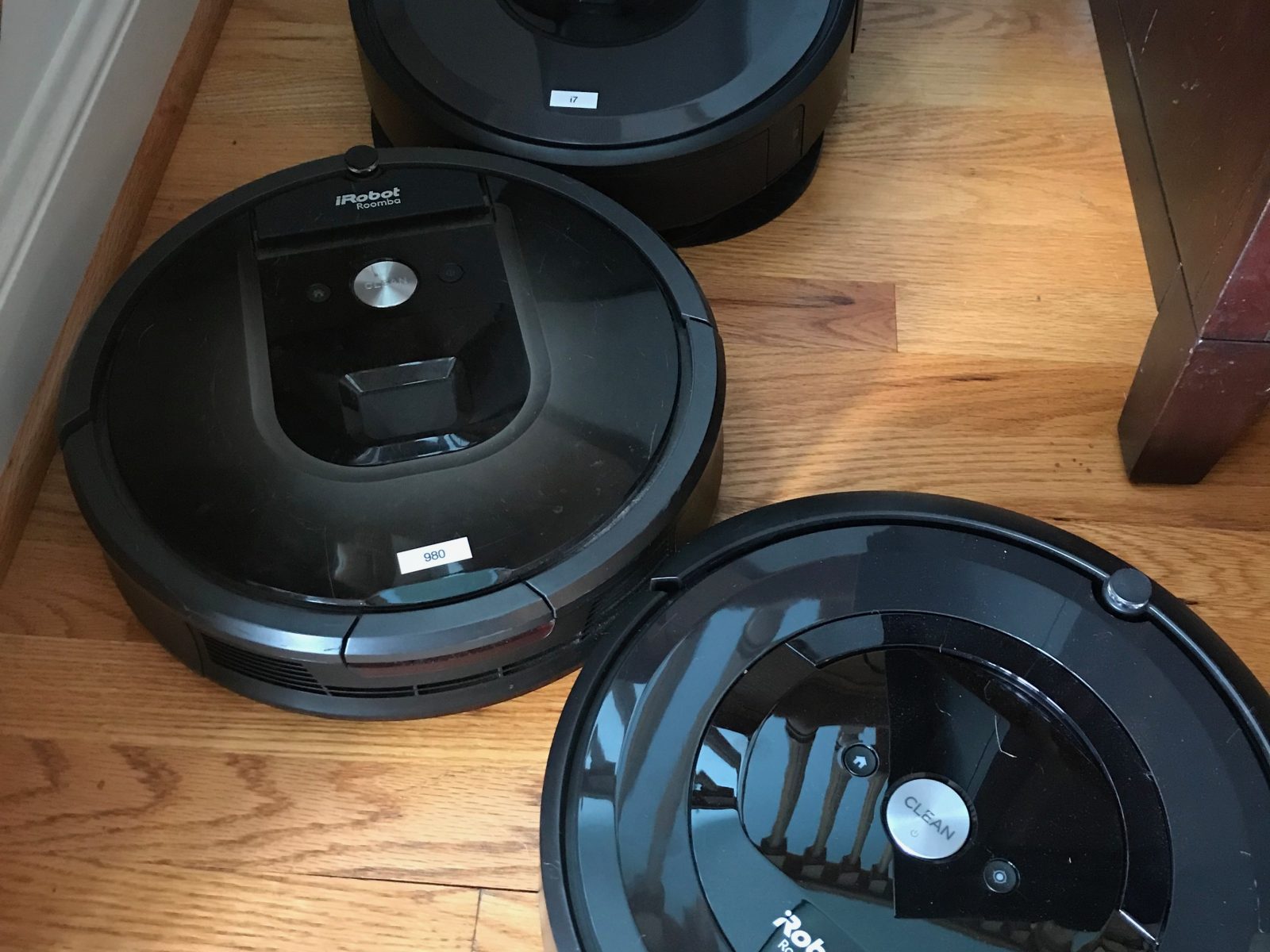
We got my mom a Roomba years ago, and it has sat in the corner gathering dust. We subsequently got ourselves a new one when the WiFi/App versions first came out. And it sat in the corner gathering dust for the most part. Fast Forward to the end of 2019.
After our cleaning service moved out of the area, we realized that the sheer amount of fur the dogs shed each day was going to bury us alive pretty quickly. We resurrected the Roomba 980 and got it running on a schedule in the family room and kitchen. But it always seemed to have problems finding its dock and recharging. And not surprisingly, the collection bin was full every time it ran. Now what?
One of the Facebook groups I belong to had a discussion about the various cleaning robots, including the new Roomba that automatically empties its own bin. This i7 model is not cheap, but as one person put it, it paid for itself in less than 3 months given the cost of a cleaning service. And it encouraged their family members to keep things picked up better.
By the second week of January, we had expanded our repertoire to include the 980, an i7, and an e5 model, each with a designated area of the house.
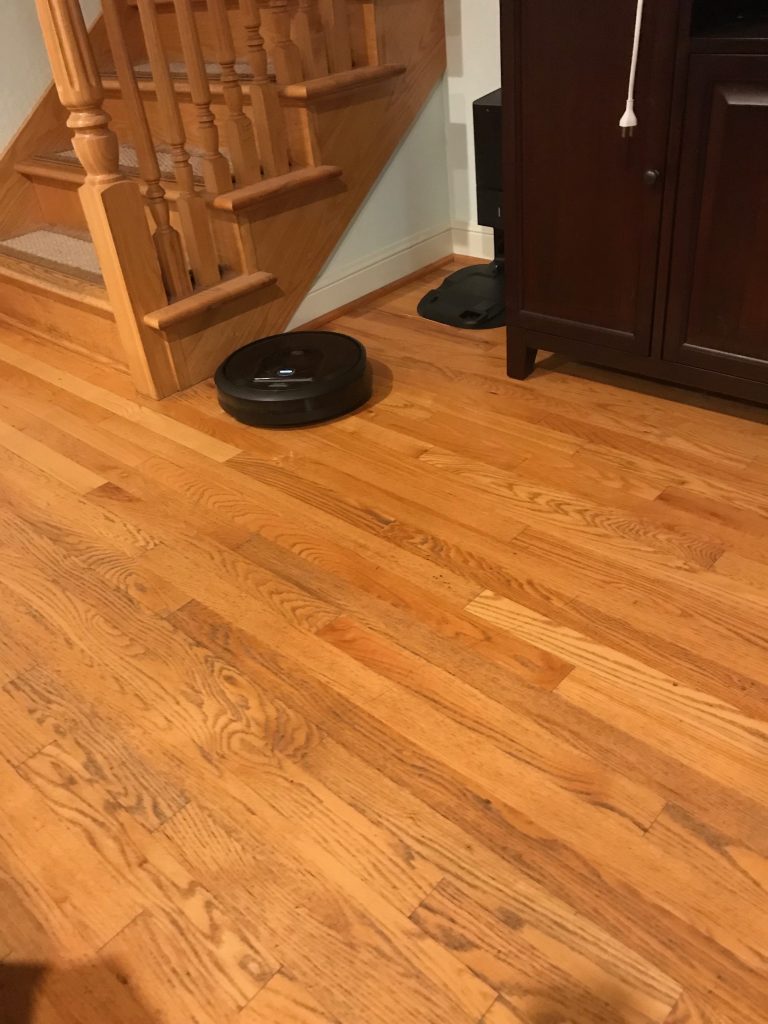
The Devices
The i7 will create a smartmap of the house, and you can designate specific areas by name. Once done, you can have the i7 clean the entire area, or a specific room. It will tell you what it cleaned on any of your prior 30 cycles, and show you areas that were particularly dirty (like near the kitchen trash can and the dog’s food bowls). It’s far quieter than the 980, and seems to be more efficient, running for about 45 minutes or so to do the primary downstairs areas, which are all hardwood or tile.
The e5 does not have the mapping capabilities of either the i7 or 980. We put it in the living room/dining room area, which sees much less traffic than the rest of the house. Because of that, you can’t see where there are particularly dirty areas that might warrent some direct attention. It also seems a bit more prone to getting stuck. We moved a couple of items to provide a wider pathway and will see what happens as we continue to use it.
The 980 has turned out to be a workhorse once properly located. The device homes in on the charging base much better now that it’s on a long wall, instead of under a corner table. It’s still noisier than the i7, and is taking longer for a smaller area, but it’s working on carpet, and it’s catching up on long-term dust under furniture like beds.
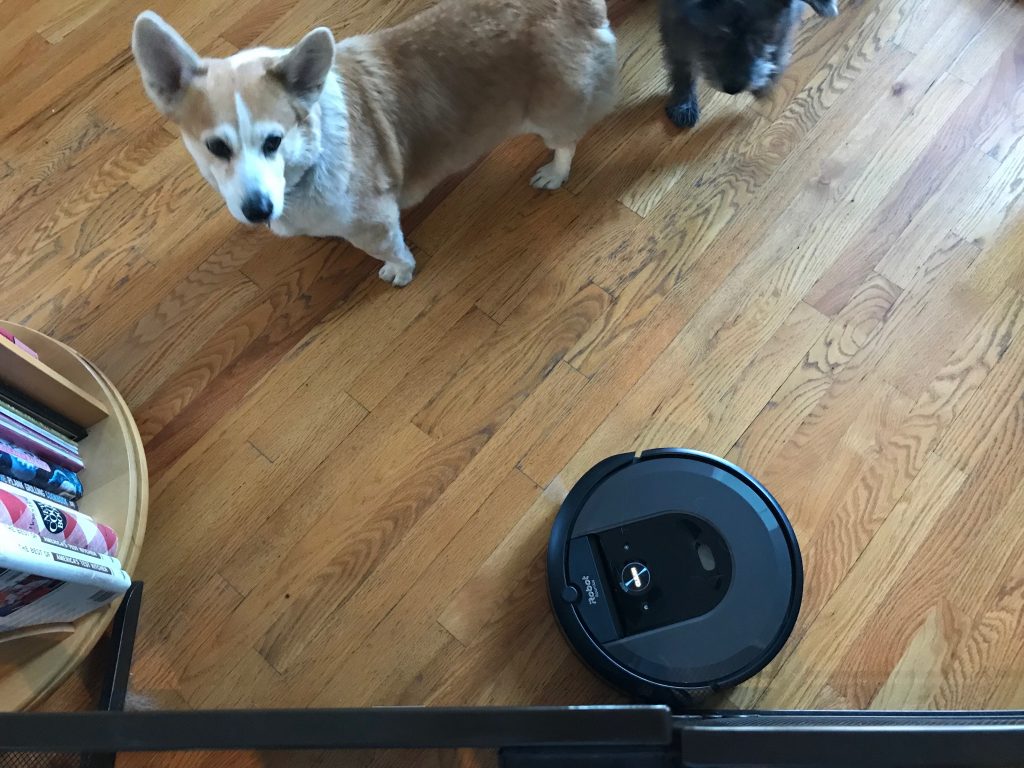
The App
The iRobot app is pretty straight forward. You can download it from the Apple Store or Google Play. The only limitation is that you can only have one login for the household. You can add multiple robots and give them custom names.
The app allows you to control the robots: start, pause, stop a job. It allows you to review what’s been done in terms of time running, “dirt events,” and will show you a map of where it cleaned if it’s the 980 or i7.
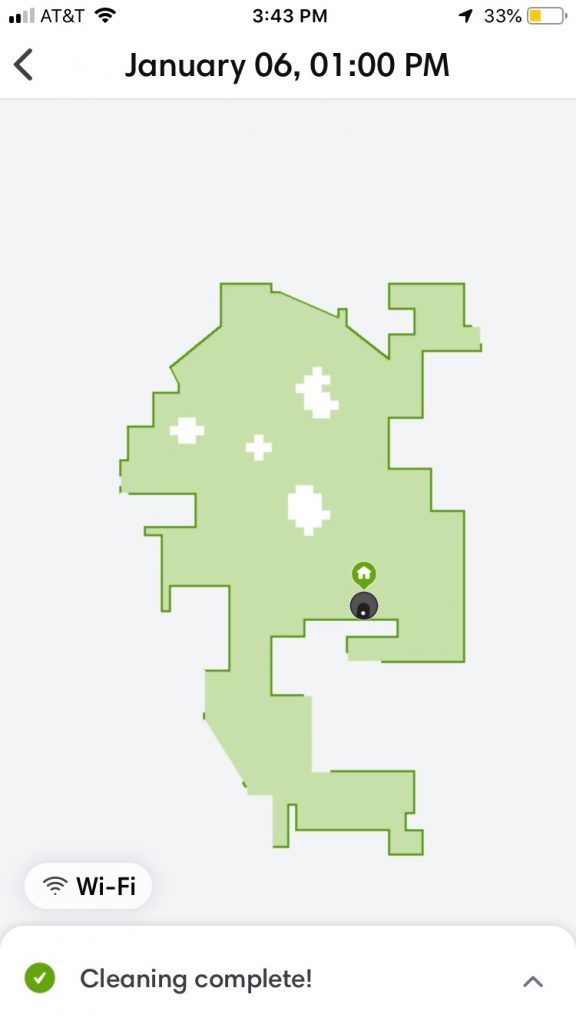
You can also now link with Amazon Alexa, and other smart home tools. You will need to turn on the association from within the iRobot app. And then you will need to discover the devices in the Alexa app. The biggest problem is getting Alexa to actually activate the devices. You also need to come up with a unique name that you can say that is recognized by the smart device. And then figuring out the correct phrase to tell Alexa what to do.
Of course… I’m still waiting for a robot that will clean the stairs!
The best camp shirt pattern
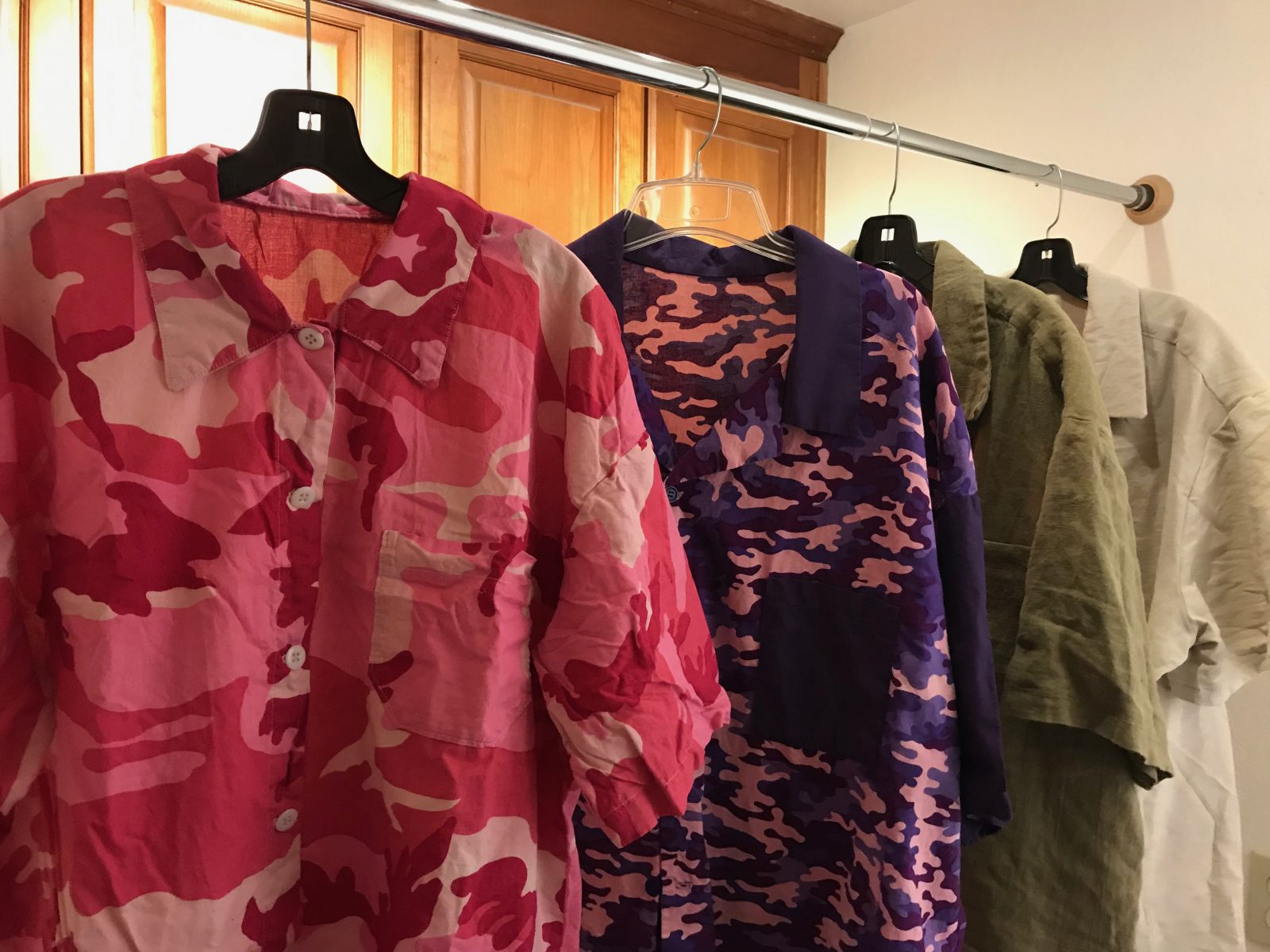
Stephen loves his hawaiian shirts, and we have a couple of friends who wear them a lot as well. I thought, since we had a couple of trips to Hawaii this year with CSA, that I would try to make us some matching/related and geekish shirts. Off to figure out a pattern to use and fabric to buy.

I started with a pattern that had been used for the Single Pattern competition at Costume-Con. McCalls 2233 is a set of pieces designed for kitchen staff — chef’s jacket, shirt, pants, apron, and toque. While the folks using this for the Single Pattern competition were very creative (klingon chef anyone?!), only one person actually made the shirt. It looked awfully big on her, with sleeves at least to her elbows. I decided to make it using some leftover fabric from the stash — the pink camo.
The pattern is actually pretty straight forward, but it’s not a true camp shirt, as the collar is not designed for the open and flat spread. It has an interesting trick of double-folding the front facing and not needing interfacing. And the shoulders are dropped *significantly* — 3″ on me — which is part of why the sleeves end up so long. And it’s really long.

Next up: McCalls 2149. This is a men’s shirt set, with collar options (camp vs band, but no stand collar style) and sleeve options (short vs long). It was interesting to see how this men’s pattern differed from the women’s patterns. It was “old-fashioned” one-size only, instead of the multi-size patterns that have become the norm for most women’s patterns. One of our friends used this for her husband’s geek shirts.
This one used the leftover purple camo, although I was short fabric for the sleeves. I got some plain purple to use for the sleeves, collar, and pocket. The assembly was interesting, as they had you attach the collar, then attach the facing, then clip deep into the collar seam to be able to close it off. It worked far better than I expected. The shoulder seam is forward of center by about an inch (which I top-stitched). The finished sleeves are still nearly elbow length.

Third time: New Look 6197. This one has both men’s and women’s multisized patterns in the same packet. The difference is in the fit of the body (with darts or not) and hem (straight vs curved). This has a back yoke in addition to the camp-style collar. Both the yoke and collar are cut cross-grain.
I grabbed some fabric from the stash – a green linen that I had picked up for Faire years ago and never used. After assembling the yoke and lower back piece, the assembly is fairly typical. This also used the collar construction as in the McCalls pattern above. However, if you want to have the yoke with two layers (as in most commercial shirts), better to cut a second yoke piece, and attach the inner yoke layer to the front facings at the shoulder seams, and then sew the entire collar down in a single seam – no clip specifically to be able to put in a hem as in the instructions (but you still will need to clip the seam so it lies flat). Then close the shoulder seams and the bottom of the yoke with a fine top-stitch just off of the seamline.
The only problem with this pattern is that there is no indication for where the pocket should be set. I used one of the other patterns for the basic location.
Total time was about 4 hours, from layout/cutting to buttonholes. And the only thing done by hand was the actual buttons.
I had gotten a 4th pattern to try, but the New Look pattern was definitely the winner. So far I’ve done 4 shirts and have 2 more on the list.